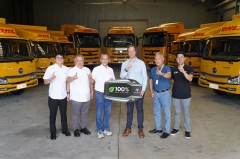
At the Global Public Transport Summit, Daimler Buses brought out its inaugural production electric bus equipped with a hydrogen fuel cell as a range extender. The introduction of the eCitaro fuel cell, which debuted at the trade fair, also marks the start of its mass production.
The standard solo version of the model is equipped with three battery packs, bearing a total capacity of 294 kWh. On the other hand, the articulated version, or bendy buses as they call them in Europe, can accommodate either three or four packs, providing an impressive combined capacity of up to 392 kWh. In both configurations, the buses are equipped with Toyota-developed fuel cells with a power output of 60 kW.

Daimler Buses has provided additional details about the fuel cell utilized in the eCitaro fuel cell model. According to Daimler, the fuel cell is described as a “tried and tested module”, specifically it’s a second-generation heavy-duty Toyota fuel cell. In the eCitaro fuel cell, the module is optimized to operate around 20 kW, which is the ideal point for performance. Its voltage range spans from 400 to 750 volts. Thanks to its sleek and compact design, the fuel cell module is conveniently installed on the roof. In the case of the solo bus, it is positioned just behind the front axle, while in the articulated bus, it is situated on the roof of the rear vehicle. The module weighs approximately 240 kilograms. Daimler says that the eCtitaro can achieve a maximum range of 350 kilometers for the articulated range-extender bus and up to 400 kilometers for the solo bus version.

The fuel cell module used in the eCitaro fuel cell model is designed to have a service life of approximately 40,000 hours when utilized as a range extender. This longevity is expected to correspond to a service life ranging from seven to ten years. The module acquires its hydrogen, in gaseous form and at a pressure of 350 bar, from Type 4 tanks that are mounted on the roof. In the case of the solo bus, there are five tanks, each with a capacity of five kilograms, resulting in a total hydrogen capacity of 25 kilograms.

For the articulated bus, there are six or seven tanks available, accommodating 30 or 35 kilograms of hydrogen, respectively. As for refueling, Daimler states, “Under optimum conditions and depending on the refueling infrastructure, the refueling time in the solo bus, for example, is around ten minutes." Right around the ballpark of the average gas stop for cars running on liquefied dinosaurs.









